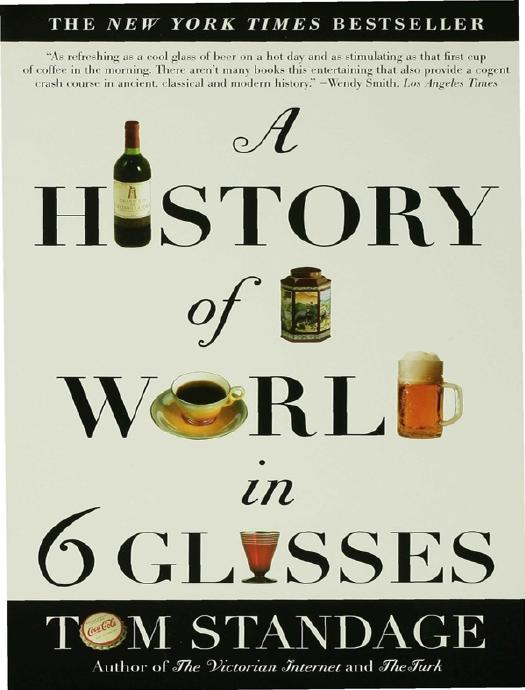A History of the World in 6 Glasses by Tom Standage

Author:Tom Standage
Language: eng
Format: mobi, epub, pdf
Tags: Non-fiction
ISBN: 9780802718594
Publisher: Atlantic Books
Published: 2005-01-02T00:00:00+00:00
8
The Coffeehouse Internet
You that delight in Wit and Mirth, and long to hear such News,
As comes from all parts of the Earth, Dutch, Danes, and Turksand Jews,
I'le send you a Rendezvous, where it is smoaking new: Go hear it at a Coffee-house—it cannot but be true . . .
There's nothing done in all the World, From Monarch to the Mouse,
But every Day or Night 'tis hurl'd into the Coffee-house.
—from "News from the Coffee-House"
by Thomas Jordan (1667)
A Coffee-Powered Network
WHEN A SEVENTEENTH-CENTURY European businessman wanted to hear the latest business news, follow commodity prices, keep up with political gossip, find out what other people thought of a new book, or stay abreast of the latest scientific developments, all he had to do was walk into a coffeehouse. There, for the price of a cup (or "dish") of coffee, he could read the latest pamphlets and newsletters, chat with other patrons, strike business deals, or take part in literary or political discussions. Europe's coffeehouses functioned as information exchanges for scientists, businessmen, writers, and politicians. Like modern Web sites, they were vibrant and often unreliable sources of information, typically specializing in a particular topic or political viewpoint. They became the natural outlets for a stream of newsletters, pamphlets, advertising free-sheets, and broadsides. One contemporary observer noted: "The Coffee-houses particularly are very commodious for a free Conversation, and for reading at an easie Rate all manner of printed News, the Votes of Parliament when sitting, and other Prints that come out Weekly or casually. Amongst which the London Gazette comes out on Mundays and Thursdays, the Daily Courant every day but Sunday, the Postman, Flying-Post, and Post-Boy, Tuesdays, Thursdays, and Saturdays, and the English Post, Mundays, Wednesdays, and Fridays; besides their frequent Postscripts." These publications also carried coffeehouse wit out into the provinces and country towns.
Depending on the interests of their customers, some coffeehouses displayed commodity prices, share prices, or shipping lists on their walls; others subscribed to foreign newsletters filled with news from other countries. Coffeehouses became associated with specific trades, acting as meeting places where actors, musicians, or sailors could go if they were looking for work. Coffeehouses catering to a particular clientele, or dedicated to a given subject, were often clustered together in the same neighborhood.
This was especially true in London, where hundreds of coffeehouses, each with its own distinctive name and sign over the door, had been established by 1700. Those around St. James's and Westminster were frequented by politicians; those near St. Paul's Cathedral by clergymen and theologians. The literary set, meanwhile, congregated at Will's coffeehouse in Covent Garden, where for three decades the poet John Dryden and his circle reviewed and discussed the latest poems and plays. The coffeehouses around the Royal Exchange were thronged with businessmen, who would keep regular hours at particular coffeehouses so that their associates would know where to find them, and who used coffeehouses as offices, meeting rooms, and venues for trade. Books were sold at Man's coffeehouse in Chancery Lane, and goods of all kinds were bought and sold in several coffeehouses that doubled as auction rooms.
Download
A History of the World in 6 Glasses by Tom Standage.epub
A History of the World in 6 Glasses by Tom Standage.pdf
This site does not store any files on its server. We only index and link to content provided by other sites. Please contact the content providers to delete copyright contents if any and email us, we'll remove relevant links or contents immediately.
| Culinary Biographies | Essays |
| Food Industry | History |
| Reference |
A Court of Wings and Ruin by Sarah J. Maas(7648)
The Death of the Heart by Elizabeth Bowen(3550)
The Sprouting Book by Ann Wigmore(3543)
Better Homes and Gardens New Cookbook by Better Homes & Gardens(3523)
BraveTart by Stella Parks(3394)
Salt, Fat, Acid, Heat: Mastering the Elements of Good Cooking by Nosrat Samin(3106)
Sauces by James Peterson(3048)
Kitchen confidential by Anthony Bourdain(3006)
The Bread Bible by Rose Levy Beranbaum(3002)
Classic by Mary Berry(2940)
Solo Food by Janneke Vreugdenhil(2927)
Ottolenghi - The Cookbook by Yotam Ottolenghi(2869)
Martha Stewart's Baking Handbook by Martha Stewart(2794)
Day by Elie Wiesel(2716)
Betty Crocker's Good and Easy Cook Book by Betty Crocker(2679)
The Plant Paradox by Dr. Steven R. Gundry M.D(2543)
My Pantry by Alice Waters(2542)
The Kitchen Counter Cooking School by Kathleen Flinn(2484)
Hot Sauce Nation by Denver Nicks(2450)
